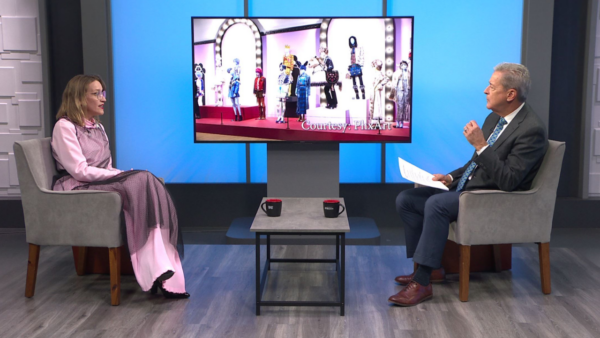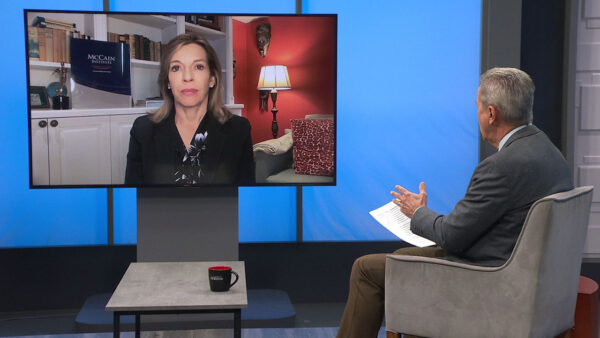Dr. Heather Shotton, former president of the National Indian Education Association and Dr. Bryan Brayboy, an ASU professor of indigenous education, will discuss Indian education issues, including student retention, graduation and higher education.
Steve Goldstein: An event will be held at Arizona State University's Tempe campus tomorrow to address issues regarding American Indian education, moving beyond the asterisk will look at the role universities can play in enabling the success of American Indian students. Joining me is one of the presenters, Dr. Heather Shotton, an assistant professor of Native American studies at the University of Oklahoma. Also here is Dr. Bryan Brayboy, an ASU professor of indigenous education. Welcome. How many students are affected by this and where did the problem originate?
Dr. Heather Shotton: I don't know in term of exact numbers. I would say the majority of native students are impacted by this issue of really relative invisibility on many campuses. It doesn't mean they are not there, but many of our institutions have a real lack of understanding of what issues native students face and how to help them to be successful.
Steve Goldstein: Why is the problem in existence in the first place? Is there a feeling Native American students have been deemphasized and ignored? You mention the word asterisk I think about the idea of just -- almost this idea that they are just there because we need to fill a gap that people think might exist, but once they get there we won't pay attention any more.
Dr. Heather Shotton: I think the asterisk represents a mentality pervasive in a lot of our higher education institutions. Oftentimes our data leaves out native people in general, creating this kind of asterisk mentality where we don't look at the issues, we don't think about native students or native people when we think about mainstream media or in our everyday curriculum in our schools. Native people are really seen in an historical sense. We don't see them in a contemporary context, so it's difficult for our institutions to address the needs of our students when we don't see them in a contemporary context.
Steve Goldstein: How much of a culture shock can it be for Native American students and what can colleges and universities do to limit that?
Dr. Heather Shotton: One, it's different for every student. To assume that all of our native students have the same experiences is a mistake. They come from different backgrounds, some from reservation areas, some from urban areas. Different tribes represent different experiences. But I do think that many of our students do encounter a different culture when they come on to our mainstream institution campuses. So it can be a bit of a culture shock. It's a different culture, a different context. I think that our universities can work with our students by understanding the tribal cultures from which they come and what values they bring with them and understanding what their unique needs are.
Steve Goldstein: Dr. Brayboy, how big a problem is this on campuses even across the west, which surprised me?
Dr. Bryan Brayboy: It's a significant issue. Heather's point is right on in terms of us needing to pay attention to native peoples in the contemporary sense. We continue to get framed as something from the past and I think these cultural issues are really important. It's also important not to just think about the cultures of their students but to pay attention to the culture of the institution. Sometimes we say this is just how they work. Part of the good work Heather and others are doing is pointing to the fact that there's culture within the institution that need to be spelled out. Sometimes rules need to be followed that are often implicit for many folks. Some of this is about making those rules and the ways the institutions work more explicit.
Steve Goldstein: Even before we get to culture on a campus per se I'm interested in how Native American students are drawn to certain universities. One thing that pops into mind for me is he wanted to make it clear some Navajo students would get in-state tuition. Many of us were surprised that didn't already exist. Because reservations are slightly different in some sense people are not treating those as in-state students. That's another problem we need to get over.
Dr. Bryan Brayboy: It is and I applaud her for her good work getting in-state tuition for members of tribal nations. Arizona's tribal nations, whether they live here or not, and reservation like Navajo covers multiple states. Students are drawn to a place like Arizona State University because of the excellence of its faculty, the excellence of the programs being offered to it. It's close enough to home to get back and forth easily via automobile or bus. And it's important to really think we're talking about the culture of the institution but that is a separate entity meaning students also want to try to go home for what some of us call cultural sustenance to try to figure out how to manage the institution while maintaining who they are as indigenous peoples.
Steve Goldstein: In general do universities do a good job of embracing diversity in a hard core sense not just paying lip service to it?
Dr. Heather Shotton: I think universities can do better. I think particularly when it comes to native students, it's important to understand that we often talk about diversity in terms of race. But what we're talking about native students we're talking about members of sovereign nations, and so universities need to do better across the nation in understanding the unique status of native students than they are citizens of sovereign nations and so with that understanding I think that that is an initial step in helping to serve native students.
Steve Goldstein: Dr. Brayboy?
Dr. Bryan Brayboy: I think that's exactly right. Sometimes what we do is fail to recognize this unique status that native peoples have. Sometimes it shows up in casinos. Why is it that we have these casinos but really what's embedded underneath that is really the unique status as tribal nations and paying more attention to that makes sense. I also think it's important that we pay attention to where institutions are located. A place like Arizona State is on land, these peoples have been living on for Millennia, having a fundamental understanding of what that is. I think most people are driving up the 101 headed north or south fail to realize they are traveling through native peoples' land that are still their lands whether they are shopping in places that are still native peoples' lands. Having a fundamental understanding that they are different places gets at the fact that we need to not move well beyond this as treating diversity as a racialized issue.
Steve Goldstein: Dr. Shotton, there shouldn't be a fear of this, of course, but there are always backlashes in these things if we start talking too much about one particular group, even one that in many ways has been ignored for generations. Is there a way to approach that so people don't feel threatened? Should we worry about that?
Dr. Heather Shotton: I think there's always that potential, especially when we're paying attention to one group. Oftentimes we hear that in our institutions, well, if we do this for native students then what about other students. We have to do it for everyone. Again, I think it goes back to our status as citizens of sovereign nations. So we're really dealing in a nation to nation approach. So one sovereign state is a sovereign to another sovereign. We're dealing with a political entity, so I think that's a really important way to approach the way that we're dealing with native students and with tribes.
Steve Goldstein: Dr. Brayboy, the generational difference. When we talk about folks who come from reservations or have a tribal background, how difficult is that in the sense as we have younger students perhaps the past generations didn't go to a large university like Arizona State, so it's even more of a culture shock than before. They don't necessarily have that relative they can lean on. How much of a challenge is that?
Dr. Bryan Brayboy: It's a tremendous challenge. If you look at the literature on this topic, what shows up is students often stay because of one really positive relationship. That positive relationship doesn't necessarily need to be with a native person, but with someone at the institution who helps navigate that institution, maybe someone who says you're going to this institution of higher learning to try to serve your community or try to make sort of make a future for yourself that's different maybe than your family's. The converse we have instances where people leave and they can often leave because of one bad relationship with an office, a individual, faculty member, staff or someone even not affiliated with the university. I do think there's a generation of people who didn't go to college, native peoples who didn't go to college, they don't necessarily know how to talk to young people about this. They are certainly committed to the issue, however, of having young people go to college. So there's support whether or not they understand the rules and the way the institution works is a different story. Fundamentally higher education is about relationships and relationships building.
Dr. Heather Shotton: I would absolutely agree. Many of our students are first generation, the first in their family, not just their immediate family, often their extended, larger family or in their communities pursuing higher education, undergraduate or graduate degree. So they don't have resources to tell them how to navigate this. Those relationships like Dr. Brayboy was saying are key. Having relationships with people on campus to help meal rate the issues, the isolation they may be feeling, not understanding how to navigate -- universities can be very complex systems. If you don't have that knowledge of how to navigate a system it can be very, very difficult to be successful. So relationships in having positive experiences are really key for native students.
Steve Goldstein: Talking about Native Americans in a monolithic sense, what should the goals be after what we hope is a good experience at a university? Is there the desire to go back and help communities? Should that be the main goal? Should it be to expand on what people are learned having left the reservation?
Dr. Heather Shotton: What we have found more and more is the motivation for college degree is to get back. Sometimes it's to give back in their home communities. How we define that is different. For some it may be giving back to the broader native community. Students are finding, graduates are finding different ways to do that. We have to do a better job of helping them figure out how to utilize their education in a way that gives back to communities and benefits the broader community seeing that that's a large motivating factor.
Steve Goldstein: Dr. Brayboy, brief conclusion?
Dr. Bryan Brayboy: I think that's exactly right. The evidence is overwhelming that for students, native students who finish institutions of higher education are motivated to give back to the larger communities. Part of our mission is to help make the society in which we live better.
Steve Goldstein: Thank you for the conversation.
Thank you.
Dr. Heather Shotton:Former President, National Indian Education Association; Dr. Bryan Brayboy:Professor, Arizona State University;























